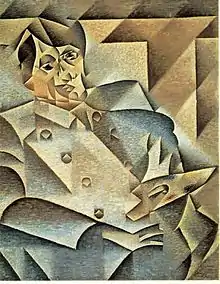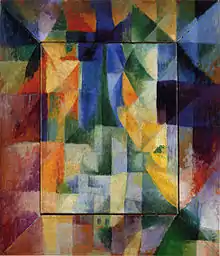Cubism has been defined in different ways by artists, critics and historians. Some have written about cubism as a form of plastic geometry.
Appolonaire's definitions
At Section d'Or in 1912, Guillame Apolonaire gave a lecture outlining 4 types of Cubism :
Scientific Cubism
Including Picasso and Braques

Physical Cubism
Le Fouconnier - who didn;t break fully with traditional perspective
Orphic
Duchamp, Picabia, Delauney

Instinctive
those jumping on the bandwagon!
Historification
Analytic v Synthetic
Analytic Cubism
Coined by Juan Gris a posteriori . Goes from 1910 to 1912 in France. Main practiced by Braque
- Use of Trompe-l'œil
- Refusal of perspective
- Multi-angled (dimension of time)
- Use of collage
- monochromatic colours.
Synthetic Cubism
- fewer and simpler forms based to a lesser extent on natural objects.
- Brighter colors
- more decorative effect,
- more use of collage and other two-dimensional materials.
until around 1919, when the Surrealist movement gained popularity.
Early/ High/Late
English art historian Douglas Cooper describes three phases of Cubism in his book, The Cubist Epoch.
Early Cubism
1906 to 1908 - developed in the studios of Picasso and Braque;
High Cubism
1909 to 1914 during which time Juan Gris emerged as an important exponent (after 1911)
Late Cubism
from 1914 to 1921) as the last phase of Cubism as a radical avant-garde movement. Douglas Cooper's restrictive use of these terms to distinguish the work of Braque, Picasso, Gris (from 1911) and Léger (to a lesser extent).
The assertion that the Cubist depiction of space, mass, time, and volume supports (rather than contradicts) the flatness of the canvas was made by Daniel-Henry Kahnweiler as early as 1920,[15] but it was subject to criticism in the 1950s and 1960s, especially by Clement Greenberg.[16] <wikipedia>
see w:Cubism